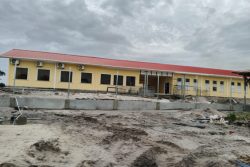(Trinidad Express) A decline in drug trafficking has caused the murder rate to increase in Trinidad and Tobago, according to a recent report from the United Nations.
This was one of the reasons given by the Government for instituting the State of Emergency. But the report’s own statistics for drug seizures appear to contradict this claim.
In announcing the State of Emergency on August 21, Prime Minister Kamla Persad-Bissessar stated: “I am advised that one of the causations for the spike in murders is ironically linked to the success by the police in the discovery of large drug hauls, with values in excess of twenty million dollars in just one raid.”
The Prime Minister was referring to a cocaine haul, with an estimated street value of $22 million, made at Piarco International Airport on August 16.
She added, “These large sums of money simply do not disappear from the drug trade without consequences, and in some of the cases now occurring, this is the result.”
In Parliament, on September 2, moving a motion to extend the State of Emergency, National Security Minister John Sandy noted that, “The country has been witnessing within recent times the tragedy of multiple murders and an upsurge in gang-related violence. Over the space of 76 hours there were 11 murders…”
Between 1999 and 2008, there was a steady increase in murders in T&T. The UN’s Office of Drugs and Crime (UNODC) Global Study on Homicide 2011 reports, “…while drug trafficking flows were diminishing, as indicated by declining quantities of drug seizures, homicide rates increased in ten out of 11 Caribbean countries for which data are available. Part of the reason for this increase in lethal violence can be traced to increased competition between drug trafficking organisations fighting for their share of a diminished market.”
The report notes that drug trafficking in the region has dropped steadily over the past 15 years.
“Between 1997 and 2009, drug seizures in the Caribbean decreased by 71 per cent,” says the report. In 1997, 30 per cent of the cocaine bound for the United States passed through the Caribbean; by 2009, this had been reduced to just ten per cent. Now, most of the cocaine passes through Central American countries, and those nations have seen their homicide rates spike.
“In the last five years, homicide rates have increased in five out of eight countries in Central America, with some countries seeing their rate more than double in the same period,” says the UNODC report.
“These trends are largely attributable to fluctuations in cocaine trafficking in Central America, which can lead to criminal conflicts as a result of both increases and decreases in drug flows, with the latter particularly resulting in increased competition between drug trafficking groups.”
However, if the UNODC is claiming that both increases and decreases in drug trafficking lead to more murders, this means its analysts are unable to prove the cause and effect that they posit.
And the report’s own statistics for T&T show no clear link in either scenario.
For example, drug seizures in this country spiked in 2001 and 2005. But there was no spike in murders in 2001 or 2002, just a steady upward climb.
And, while there was jump in homicides in 2005, this dropped in 2006. On the other side of the coin, drug seizures dropped drastically in 2007, but the next murder spike occurred in 2008.
Table 1, below, shows that neither drug seizures nor local drug-related offences correlate, either negatively or positively, with the number of murders.
If the UNODC’s claims were correct, then there should have been spikes either when drug seizures increased or decreased. This is not the case.
And if the Government’s claims were accurate, gang-related murders should have risen every year there were large drug seizures.
In 2005, 1.75 tonnes of pure cocaine, with an estimated street value of over $700 million, were seized from a house on Monos Island.
That year did see an increase in murders, but only ten of the 386 were classified as drug-related and 81 as gang-related. In 2006, 77 of the 391 murders were drug-related. By contrast, gang-related murders spiked in 2007 and 2008—the same years when drug seizures dropped, and when 44 and 35 murders, respectively, were drug-related.
Since August 21, when the State of Emergency was declared, 745 persons have been arrested for drug offences, and an estimated $750 million worth of drug seized.
However, this sum is almost entirely accounted for by marijuana rather than the cocaine which is transshipped through Trinidad from South America.
And not one person among the 745 arrested has been charged in relation to these large shipments.








